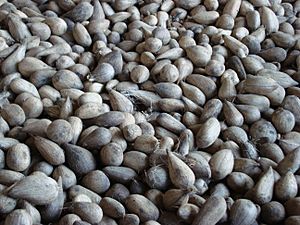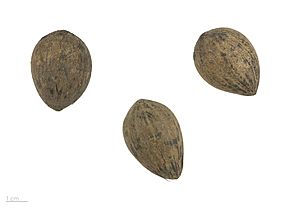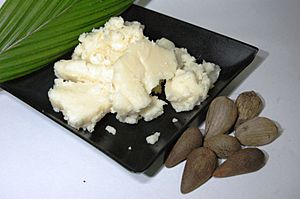Astrocaryum murumuru facts for kids
Quick facts for kids Astrocaryum murumuru |
|
|---|---|
 |
|
| Drying murumuru seeds | |
| Scientific classification | |
| Genus: |
Astrocaryum
|
| Species: |
murumuru
|
| Synonyms | |
|
|
The Astrocaryum murumuru palm is often called murumuru in Portuguese. It is a type of palm tree that grows naturally in the Amazon Rainforest in Brazil. This special palm tree produces fruits that you can eat.
People also get murumuru butter from the seeds of this plant. This butter is great for making your skin soft and smooth. One very interesting thing about the murumuru palm is that it has long, sharp spines. These spines can be as long as 30 centimeters (about 12 inches)!
Murumuru palm trees are very common in the Amazon region. They have thick trunks and bushy tops that look a bit like a shuttlecock. The fruits are full of nutrients and are an important food source for local people. Parts of the tree, its fruit, and seeds are also used to make things that are sold. For example, people make hammocks from the tree's strong fibers.
Murumuru butter is known for being very moisturizing. It can also form a protective layer and make things look shiny. These qualities help it protect your skin and hair. The butter contains important vitamins and a lot of oleic acid. The oil from the seeds has been used for a long time to make hair soft and keep it healthy. Murumuru butter is a white to yellowish fat that comes from the seeds of the murumuru palm.
Where Murumuru Palms Grow
The Murumuru palm (Astrocaryum murumuru) is found all over the Brazilian Amazon. It also grows near the borders of Bolivia and Peru. These palms like to grow in areas that get flooded sometimes. You can often find them on islands and in lowlands along the Amazon River and its smaller rivers. They grow well in thick or slightly open forests.
You can also see many Murumuru palms in the lowlands of Marajo Island. The stem, leaves, and fruit stalks of the palm are covered with hard, black spines. These spines can be longer than 20 centimeters. This makes it tricky to pick the fruits!
When the fruit is ripe, the whole cluster of flowers and fruits falls to the ground. The fruit has yellow flesh inside. Rodents, like mice and rats, often eat this yellow flesh. They leave the seeds clean. The hard shell around the seed can only be removed when it is dry.
Murumuru Butter: What's Inside?
Murumuru butter contains special fats called lauric, myristic, and oleic acids. The butter from the fruit is white and does not have a smell or taste. A great thing about murumuru butter is that it does not go bad easily.
Murumuru butter is similar to the fats found in Tucumã palm and coconut palm seeds. However, murumuru butter is firmer because it melts at a higher temperature (33 degrees Celsius). Tucumã palm butter melts at 30 degrees Celsius, and coconut palm butter melts at 22.7 degrees Celsius.
Because murumuru butter is firmer, it can be mixed with other plant-based butters that melt at lower temperatures. It can even be used in chocolate to make it firmer, especially in warmer places.
Murumuru butter also has a low acidity (4% to 5%), especially when made from fresh seeds. This means it costs less to make it pure.
In the 1940s and 1950s, murumuru butter was very popular in Europe and the United States. It was used in vegetable creams and soaps. Today, soaps made with murumuru butter and Ucuuba butter can leave a protective layer on your skin. This layer is like silicone, but it does not block your pores.
Murumuru butter is used in small amounts in many products. You can find it in shampoos (0.5% to 1%), conditioners, creams, soaps, lipsticks, and deodorants (0.5% to 8%).
See also
 In Spanish: Murumuru para niños
In Spanish: Murumuru para niños



